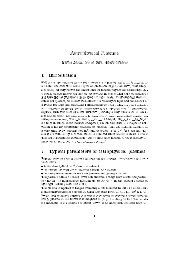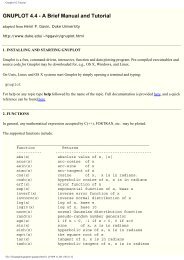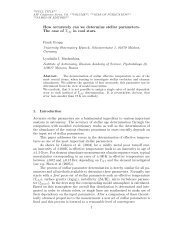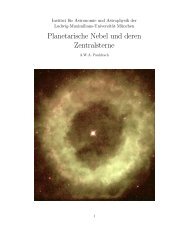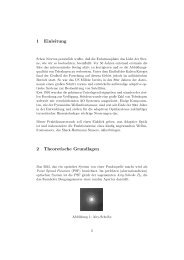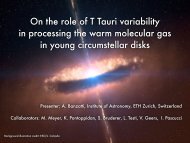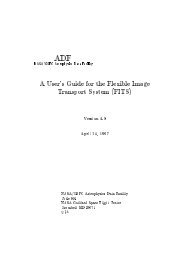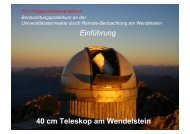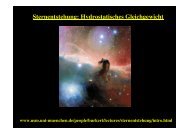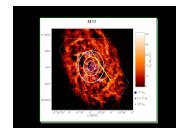VIRUS: a hugely replicated integral field spectrograph for HETDEX
VIRUS: a hugely replicated integral field spectrograph for HETDEX
VIRUS: a hugely replicated integral field spectrograph for HETDEX
You also want an ePaper? Increase the reach of your titles
YUMPU automatically turns print PDFs into web optimized ePapers that Google loves.
Table 1Basic Properties of <strong>VIRUS</strong>IFUCollimatorCameraDisperser246 fibers, each 200 µm dia. or 1.0 sq. arcsec. areasquare <strong>for</strong>mat 29 x 29 arcsec 2 , 1/3 fill-factor, hexagonal packfed at f/3.65 at prime focus of HETaccepts f/3.35, reverse Schmidt reflective designf/1.33 Schmidt with 2k x 2k 15 µm pxl CCD at internal focusVPH grating gives 340-570 nm simultaneous coverage at R∼850The <strong>VIRUS</strong> Spectrograph and Integral Field Unit: A detailed descriptionof the <strong>VIRUS</strong> opto-mechanical design will be given elsewhere, but isdiscussed in (5), and summarized in Table 1. Here we concentrate on the IFUdesign. It is essential to couple <strong>VIRUS</strong> to the HET with fibers due to theweight and space constraints at the prime focus of the telescope. In addition,the variable effects of the changing pupil illumination of HET during atrack are mostly removed by radial scrambling along a fiber, producing muchgreater stability in the data calibration than is possible with an imaging <strong>spectrograph</strong>.HET has a fast focal ratio in order to couple efficiently to fibers,and <strong>VIRUS</strong> will use a densepak-type IFU (2). The layout of the fibers is in ahexagonal pack with a 1/3 fill-factor. This is most optimal <strong>for</strong> covering area,since a dither-pattern of three exposures exactly fills the <strong>field</strong> of the IFU,while maximizing the area covered per IFU. Lenslet-coupled fiber IFUs havethe principal advantages of providing contiguous coverage of a small <strong>field</strong>, andallowing the slow f-ratio beams of large telescopes to be coupled efficiently tofibers. However, lenslets suffer from significant inefficiencies in the couplingbetween the micro-pupils created by the lenslets and the fibers, due to lensquality and diffraction effects (8). If the fiber core is oversized to mitigatethese effects, then resolution is lost (5; 8). For fibers fed at the same f-ratio,the bare bundle will cover the same area of sky in three exposures as does alenslet system, but offers significantly higher overall throughput (5).The design of the IFU follows experience with the PPAK bundle (7), andinitial tests are reported in (3). The 1/3 packing fraction at the IFU input isnot naturally achieved with polyamide-buffered fiber, and softer buffer materialsdo not polish well, so we have investigated two approaches to establishthe spacing. In the first, a matrix of thin-walled fused silica capillary tubingwith appropriate inner and outer diameters (Polymicro TSP250350 250 µmID, 360 µm OD, polyamide coated) is set up in a precision <strong>for</strong>m, and thenpopulated with Polymicro FBP200220240 fiber that has 240 µm nominal OD.In the second approach, precision holes of 0.25 mm diameter are drilled in aplastic plate, where the fiber is inserted. Both approaches have been successfulin creating spacings with better than 4 µm rms error in the pitch. Manualthreading of the fiber into these matrices is remarkably easy, though handling3






